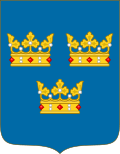List of urban areas in Sweden by population
This is a list of urban areas in Sweden by population.
The population is measured by Statistics Sweden. The statistics bureau uses the term tätort (locality or urban area), which is defined as a continuous built-up area with a maximum distance of 200 m between residences. The localities are geographical and statistical units, totally independent of the administrative and political subdivision in counties and municipalities.
The urban areas in Sweden with more than 20,000 inhabitants as of 2015, according to Statistics Sweden, who only releases these statistics every five years,[1] are:
- Stockholm – 1,515,017
- Gothenburg – 599,011
- Malmö – 316,588
- Uppsala – 160,462
- Upplands Väsby and Sollentuna urban areasv – 144,826
- Västerås – 122,953
- Örebro – 120,650
- Linköping – 111,267
- Helsingborg – 109,869
- Jönköping – 96,996
- Norrköping – 96,766
- Lund – 91,940
- Umeå – 87,404
- Gävle – 76,761
- Borås – 73,782
- Södertälje – 73,383
- Eskilstuna – 69,816
- Halmstad – 69,419
- Växjö – 68,059
- Karlstad – 64,031
- Sundsvall – 58,436
- Östersund – 51,132
- Trollhättan – 49,897
- North-east Gothenburg urban area – 46,675
- Luleå – 44,208
- Borlänge – 42,947
- Lidingö – 42, 466
- Tumba – 42,227
- Kristianstad – 40,926
- Kalmar – 40,047
- Falun – 38,356
- Skövde – 38,106
- Nyköping - 38,069
- Karlskrona – 37,165
- Uddevalla – 36,028
- Skellefteå – 35,775
- Varberg – 35,151
- Åkersberga – 34,246
- Landskrona – 33,049
- Örnsköldsvik – 32,976
- Vallentuna – 32,615
- Motala – 31,385
- Trelleborg – 30,436
- Märsta – 29,162
- Ängelholm – 28,251
- Lerum – 27,791
- Karlskoga – 27,556
- Alingsås – 27,266
- Sandviken – 25,530
- Falkenberg – 24,705
- Kungälv – 24,511
- Katrineholm – 24,271
- Visby – 24,272
- Vänersborg – 23,652
- Torslanda – 23,548
- Lidköping – 23,431
- Enköping – 23,402
- Piteå – 23,350
- Gustavsberg – 23,395
- Västervik – 21,451
- Karlshamn – 20,387
See also
- List of urban areas in Sweden
- Largest metropolitan areas in the Nordic countries
- List of metropolitan areas in Sweden
- List of cities in Sweden
- List of urban areas in Denmark by population
- List of urban areas in Norway by population
- List of urban areas in the Nordic countries
- List of urban areas in Finland by population
- List of cities and towns in Greenland
References
- "Folkmängden per tätort. Vart femte år 1960 - 2016". statistikdatabasen.scb.se (in Swedish). Statistics Sweden. Retrieved 5 November 2017. Another number was released dated 2016, using updated population data, but 2015 urban area boundaries, meaning expansion was ignored.
This article is issued from Wikipedia. The text is licensed under Creative Commons - Attribution - Sharealike. Additional terms may apply for the media files.
